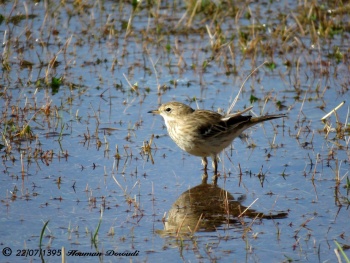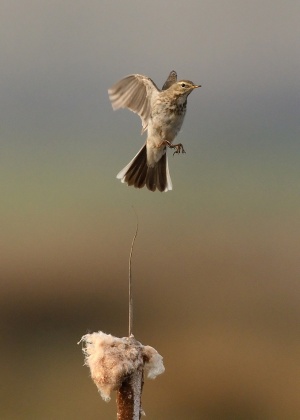- Anthus spinoletta
Identification
15–17 cm (6-6¾ in)
Summer Plumage:
- More or less unstreaked underparts
- Vinous flush on breast
- Greyish unmarked mantle and head
- Completely white outer web on outer tail feathers
Similar Species
Similar in build to Rock Pipit, being robust and significantly larger and longer-tailed than Meadow Pipit.
In winter, Water Pipits are browner than Rock Pipits with much clearer, whiter more sharply and lightly streaked underparts, less streaked mantles and more strikingly pale wing-bars. The supercilium tends to be the dominant facial feature, (eye-ring in Rock Pipit). Water Pipits often have black legs but many wintering birds do have pale legs. The completely white outer web to the outer tail feathers of a Water Pipit should rule out most Rock Pipits, though to be 100% certain, there is a white tip to the second outermost tail feather which is never more than small and off white in even the palest, most bleached littoralis Rock Pipit.
Length of hind claw in Water Pipit is variable, so a long-clawed bird does not have to be a Meadow Pipit (contra some field guides).[4]
Distribution
Southern Europe and southern temperate Asia across to China.
Taxonomy
Forms a superspecies with Rock Pipit and Buff-bellied Pipit. Localised from the former on habitat preferences and by the latter on range, though there is some evidence of interbreeding.
Subspecies
There are 3 subspecies[1]:
- A. s. spinoletta:
- A. s. coutellii:
- Eastern Turkey to Caucasus, northern Iran and Turkmenistan
- A. s. blakistoni:
- North-eastern Afghanistan to Transbaikalia and Nan Shan Mountains
Habitat

Photo by Houman Doroudi (Tormtay)
Neor Lake, Soubatan, Gilan, Iran, October 2016
It breeds in mountain meadows, and winters on coasts, estuaries, marshes, flooded fields and water margins.
Behaviour
Flight
A dipping flight. Hops or runs.
Diet
The diet includes insects and larvae.
Breeding
The clutch consists of 4 - 5 eggs which are incubated by the female for 14-15 days. The young fledge after a further 15-16 days.
Vocalisation
Call is a strong Zinc, subtly different to Rock Pipit's Fisst
References
- Clements, J. F., T. S. Schulenberg, M. J. Iliff, D. Roberson, T. A. Fredericks, B. L. Sullivan, and C. L. Wood. 2016. The eBird/Clements checklist of birds of the world: v2016, with updates to August 2016. Downloaded from http://www.birds.cornell.edu/clementschecklist/download/
- RSPB
- BTO Bird Facts
- Birdforum thread discussing a long-clawed Water Pipit
Recommended Citation
- BirdForum Opus contributors. (2025) Water Pipit. In: BirdForum, the forum for wild birds and birding. Retrieved 11 May 2025 from https://www.birdforum.net/opus/Water_Pipit
External Links
GSearch checked for 2020 platform.1






